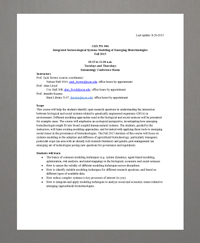Course 4
Taught each Fall semester to second year IGERT students
The first part of the course will be largely lecture-based, led by Lloyd (Mathematics and Biomathematics) and Kuzma (Public Administration). Case studies will be team-taught, with guest lecturers drawn from a number of departments providing different disciplinary viewpoints. The second part of the course will be a mixture of lecture and computer labs, providing both theoretical and practical, hands-on experience of the processes of model development and utilization. The course will culminate with the development of models combining processes and information from different areas. An example of an integrative capstone project would be a dynamic cost-benefit analysis of the implementation of a mosquito GPM program. The biological components of the model (targeted pests, competing species and genetic control dynamics) will be integrated with dynamic models of human behavior responding to the economic and cultural changes associated with the pest control (Students with advanced knowledge of modeling techniques will serve as TAs and may give lectures, tutor or lead discussions).
Baseline learning outcomes
After completing the course, students will be able to:
- Identify the purposes and value of modeling in research,
- Explain disciplinary terminology and methods, using experience gained through exploration of case studies from different disciplines,
- Discuss similarities and differences among modeling approaches (e.g., qualitative/quantitative, mechanistic/statistical, analytic/simulation, strategic/tactical),
- Utilize systems thinking theory and methodology to profile a problem area, including being able to critically evaluate system boundaries, identify system parts and evaluate system dynamics using both qualitative and computational tools and methods,
- Formulate models at appropriate scales and complexity, appreciating that these are dependent on the questions being addressed, pre-existing knowledge of the system and the quality of available data,
- Critique a model and its application to a given setting, explaining what factors lead to strengths or weaknesses of the model and its use,
- Develop models to investigate the system-level operation of a process and appreciate that nonlinear interactions between simple components can lead to complex and often counter-intuitive system behavior.
